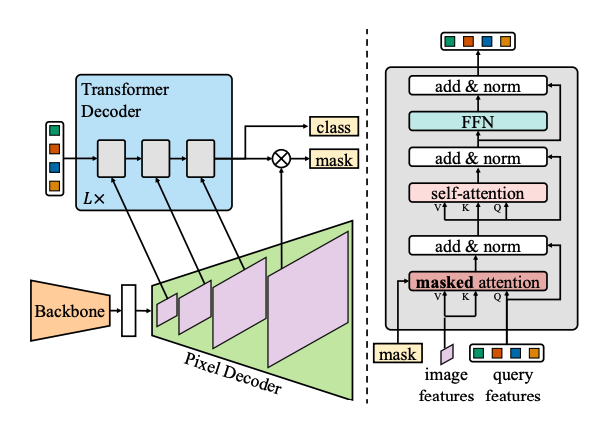|
--- |
|
license: mit |
|
tags: |
|
- vision |
|
- image-segmentation |
|
datasets: |
|
- YouTubeVIS-2021 |
|
--- |
|
|
|
# Video Mask2Former |
|
|
|
Video Mask2Former model trained on YouTubeVIS-2021 instance segmentation (large-sized version, Swin backbone). It was introduced in the paper [Mask2Former for Video Instance Segmentation |
|
](https://arxiv.org/abs/2112.10764) and first released in [this repository](https://github.com/facebookresearch/Mask2Former/). |
|
Video Mask2Former is an extension of the original Mask2Former paper released under the name, [Masked-attention Mask Transformer for Universal Image Segmentation](https://arxiv.org/abs/2112.01527). |
|
|
|
Disclaimer: The team releasing Mask2Former did not write a model card for this model so this model card has been written by the Hugging Face team. |
|
|
|
## Model description |
|
|
|
Mask2Former addresses instance, semantic and panoptic segmentation with the same paradigm: by predicting a set of masks and corresponding labels. Hence, all 3 tasks are treated as if they were instance segmentation. Mask2Former outperforms the previous SOTA, |
|
[MaskFormer](https://arxiv.org/abs/2107.06278) both in terms of performance an efficiency by (i) replacing the pixel decoder with a more advanced multi-scale deformable attention Transformer, (ii) adopting a Transformer decoder with masked attention to boost performance without |
|
without introducing additional computation and (iii) improving training efficiency by calculating the loss on subsampled points instead of whole masks. |
|
|
|
In the paper [Mask2Former for Video Instance Segmentation |
|
](https://arxiv.org/abs/2112.10764), the authors have shown that Mask2Former also achieves state-of-the-art performance on video instance segmentation without modifying the architecture, the loss or even the training pipeline. |
|
|
|
 |
|
|
|
## Intended uses & limitations |
|
|
|
You can use this particular checkpoint for instance segmentation. See the [model hub](https://huggingface.co/models?search=video-mask2former) to look for other fine-tuned versions of this model that may interest you. |
|
|
|
### How to use |
|
|
|
Here is how to use this model: |
|
|
|
```python |
|
import torch |
|
import torchvision |
|
from huggingface_hub import hf_hub_download |
|
from transformers import AutoImageProcessor, Mask2FormerForUniversalSegmentation |
|
|
|
|
|
# load Mask2Former fine-tuned on COCO instance segmentation |
|
processor = AutoImageProcessor.from_pretrained("facebook/video-mask2former-swin-large-youtubevis-2021-instance") |
|
model = Mask2FormerForUniversalSegmentation.from_pretrained("facebook/video-mask2former-swin-large-youtubevis-2021-instance") |
|
|
|
file_path = hf_hub_download(repo_id="shivi/video-demo", filename="cars.mp4", repo_type="dataset") |
|
video = torchvision.io.read_video(file_path)[0] |
|
video_frames = [image_processor(images=frame, return_tensors="pt").pixel_values for frame in video] |
|
video_input = torch.cat(video_frames) |
|
|
|
with torch.no_grad(): |
|
outputs = model(**video_input) |
|
|
|
# model predicts class_queries_logits of shape `(batch_size, num_queries)` |
|
# and masks_queries_logits of shape `(batch_size, num_queries, height, width)` |
|
class_queries_logits = outputs.class_queries_logits |
|
masks_queries_logits = outputs.masks_queries_logits |
|
|
|
# you can pass them to processor for postprocessing |
|
result = image_processor.post_process_video_instance_segmentation(outputs, target_sizes=[tuple(video.shape[1:3])])[0] |
|
# we refer to the demo notebooks for visualization (see "Resources" section in the Mask2Former docs) |
|
predicted_video_instance_map = result["segmentation"] |
|
``` |
|
|
|
For more code examples, we refer to the [documentation](https://huggingface.co/docs/transformers/master/en/model_doc/mask2former). |